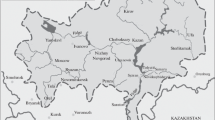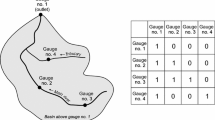Abstract
In this paper, possible ways to increase effectiveness of the long-term ensemble spring floods forecasting and to assess their uncertainty based on the physical-mathematical model of the runoff formation (for the Vyatka River case study) are studied. It is shown that deterministic forecasts issued by using this approach are more accurate than those obtained from the traditional forecasting methods based on regression relationships. Probabilistic methods of forecasting of the spring flood volume and maximum discharge, which are issued by using various ways of the weather ensembles setting, are compared. Reliability of probabilistic forecasts of the volume and maximum discharge is estimated.
Similar content being viewed by others
References
L. K. Vershinina and O. I. Krestovskii, “Taking into Account the Catchments Saturation Capacity for Spring Floods Forecasting,” Trudy GGI, No. 265 (1980) [Trans. State Hydrological Inst., No. 265 (1980)].
G. V. Gruza and E. Ya. Ran’kova, Probabilistic Meteorological Forecasts (Gidrometeoizdat, Leningrad, 1983) [in Russian].
E. S. Zmieva, Forecasts of the Water Inflow in the Kuibyshevskoe and Volgogradskoe Reservoirs (Gidrometeoizdat, Leningrad, 1964) [in Russian].
L. S. Kuchment and A. N. Gelfan, “Long-term Ensemble Forecast of Snowmelt Runoff with the Help of the Physics-based Models of Runoff Generation,” Meteorol. Gidrol., No. 2 (2007) [Russ. Meteorol. Hydrol., No. 2, 32 (2007)].
L. S. Kuchment and A. N. Gelfan, “Physicomathematical Model of Snow Accumulation and Melt in a Forest,” Meteorol. Gidrol., No. 5 (2004) [Russ. Meteorol. Hydrol., No. 5 (2004)].
L. S. Kuchment, V. N. Demidov, Yu. G. Motovilov, and V. Yu. Smakhtin, “A System of Physically Based Models of Hydrological Processes and Experience of its Application to Problems of the River Runoff Formation,” Vodnye Resursy, No. 5 (1986) [Water Resources, No. 5 (1986)].
Instruction oh Hydrological Forecasts, No. 1: Long-term Forecasts of the Rivers and Reservoirs Water Regime Elements (Gidrometeoizdat, Leningrad, 1989) [in Russian].
J. K. Franz, H. C. Hartmann, S. Sorooshian, and R. Bales, “Verification of National Weather Service Ensemble Streamflow Predictions for Water Supply Forecasting in the Colorado River Basin,” J. Hydrometeorology, 4 (2003).
A. N. Gelfan, “Physically Based Model of Heat and Water Transfer in Frozen Soil and its Parameterization by Basic Soil Data,” in Predictions in Ungauged Basins: Promises and Progress. Proc. 7th IAHS Scientific Assembly at Foz do Iguazu, Brazil, April 2005, Ed. by M. Sivapalan et al. (IAHS Publ., 2006), Vol. 303.
T. Hashino, A. A. Bradley, and S. S. Schwartz, “Verification of Probabilistic Streamflow Forecasts,” IIHR-Hydroscience and Engineering and Dep. Civil and Env. Eng., The University of Iowa, IIHR Report No. 427 (2002).
F. Weber, L. Perreault, and V. Fortin, “Measuring the Performance of Hydrological Forecasts for Hydropower Production at BC Hydro and Hydro-Québec,” in Proc. 18th Conference on Climate Variability and Change. Annual Meeting, American Meteorological Society (AMS), 29 January–2 February, Atlanta, Georgia, 2006 (http://ams.confex.com/ams/pdfpapers/101960.pdf).
D. S. Wilks, Statistical Methods in the Atmospheric Sciences (Academic Press, San Diego, 1995).
Author information
Authors and Affiliations
Additional information
Original Russian Text © L.S. Kuchment, A.N. Gelfan, 2009, published in Meteorologiya i Gidrologiya, 2009, No. 2, pp. 54–67.
About this article
Cite this article
Kuchment, L.S., Gelfan, A.N. A study of effectiveness of the ensemble long-term forecasts of spring floods issued with physically based models of the river runoff formation. Russ. Meteorol. Hydrol. 34, 100–109 (2009). https://doi.org/10.3103/S106837390902006X
Received:
Published:
Issue Date:
DOI: https://doi.org/10.3103/S106837390902006X




